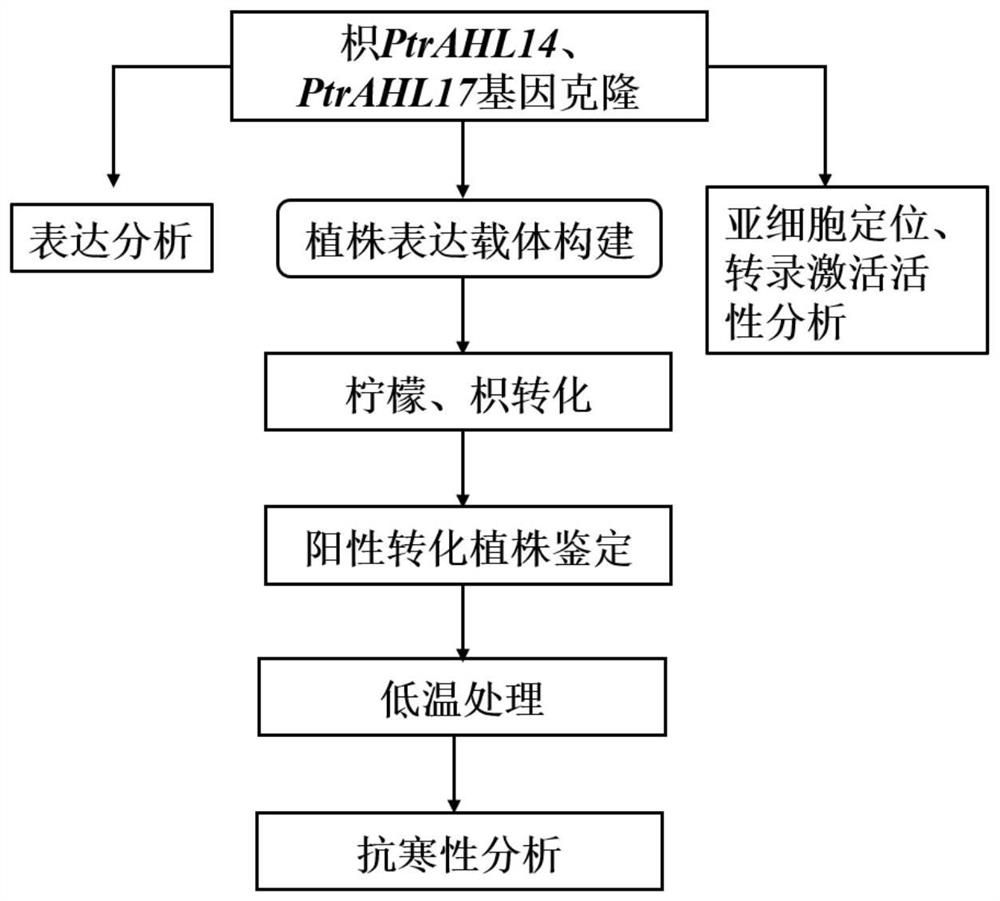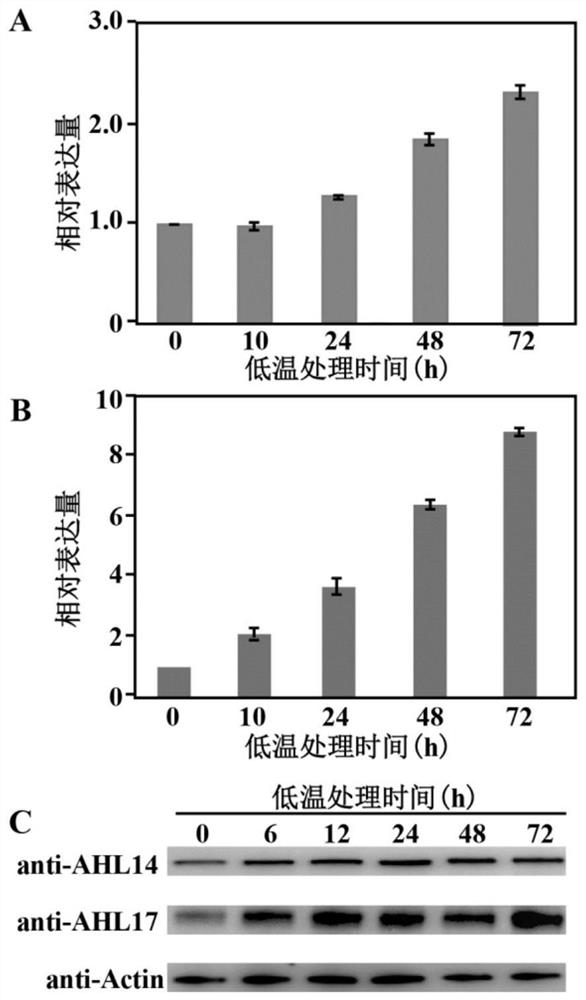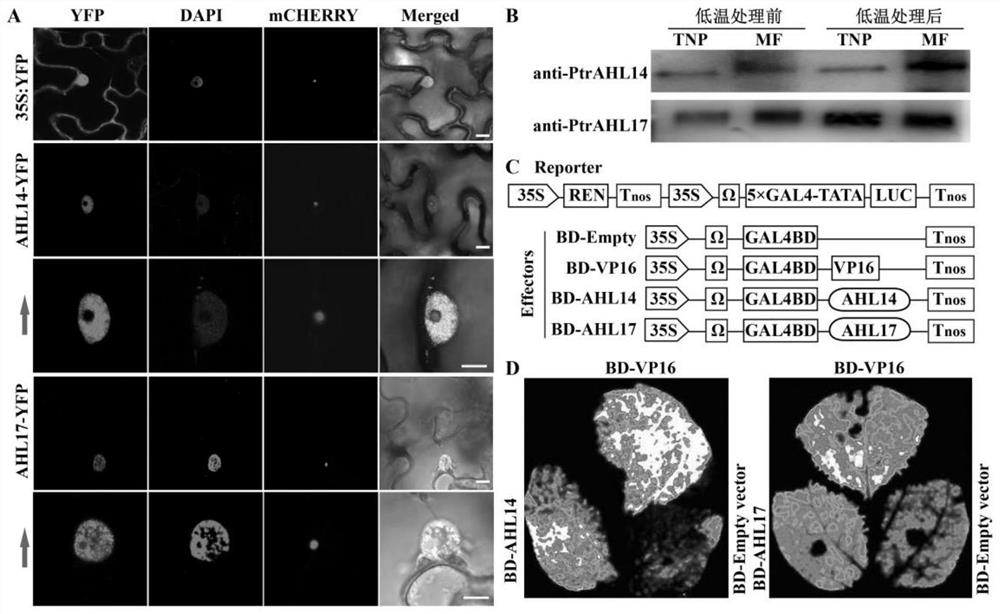Hovenia trifoliate transcription factor ptrahl and its application in genetic improvement of plant cold resistance
A transcription factor and plant technology, applied in the field of plant genetic engineering, to reduce agricultural production costs and achieve environmental friendliness
- Summary
- Abstract
- Description
- Claims
- Application Information
AI Technical Summary
Problems solved by technology
Method used
Image
Examples
Embodiment 1
[0030] Example 1: Cloning of full-length cDNAs of Citrus aurantium PtrAHL14 and PtrAHL17 genes
[0031] Using Citrus citrus cDNA as a template, high-fidelity enzyme was used for amplification. The amplification primer sequences were: Forward primer for PtrAHL14 gene amplification: 5'-ATGGAACCAAATGATACGCAGC-3' and reverse amplification primer: 5'-CTAGTCTGCAATTTGGTCATAAGTC-3' ; Forward primer for amplification of PtrAHL17 gene: 5'-ATGAAAAGTGATTATGTAGTAGAACCC-3' and reverse primer for amplification: 5'-TCAATAAGGCGGTGGTGGGTGG-3';
[0032] AxyPrep-96 DNA gel recovery kit was used to purify and recover the amplified product. Using DNA seamless cloning technology, the purified product was ligated into pEASY-Blunt vector, and then the ligated product was transformed into DH5α competent cells, plated, shaken bacteria, and then a positive identification was performed. The positive clones were obtained and sent to Wuhan Qingke Biological Company for sequencing. According to the sequenci...
Embodiment 2
[0034] Example 2: Expression analysis of PtrAHL14 and PtrAHL17 under low temperature treatment
[0035] Take wild-type citrus aurantium seedlings that are 2 months old and have the same growth, and place them in a low-temperature incubator (HP400G-E, Ruihua, China) for low-temperature treatment (4°C), and the sampling time points are 0h, 6h, and 10h. , 12h, 24h, 48h, 72h. The leaves were collected at each time point and quickly placed in liquid nitrogen for freezing, and then placed in a -80°C refrigerator for later use in gene expression pattern analysis and immunoblotting experiments.
[0036] The low-temperature expression patterns of PtrAHL14 and PtrAHL17 genes were analyzed by real-time fluorescence quantitative PCR (qRT-PCR). AceQ qPCR SYBR Green Master Mix reagent was used for real-time fluorescence quantitative PCR, and the method was referred to the instructions. The prepared reaction system was reacted with QuantStudioTM7Flex Real-Time PCR fluorescence quantitative ...
Embodiment 3
[0039] Example 3: Analysis of PtrAHL14 and PtrAHL17 Subcellular Localization and Transcriptional Activation Activity
[0040] The ORF regions of PtrAHL14 and PtrAHL17 (without stop codon) were amplified and fused to the vector pEG104 (with YFP protein), and the expression was driven by the CaMV35S promoter. Afterwards, the control 35S:YFP+mCherry, 35S:PtrAHL14-YFP+mCherry, 35S:PtrAHL17-YFP+mCherry were transiently transformed into the leaf epidermal cells of N. benthamiana respectively, and the fluorescence of the control was observed by confocal microscopy and found that the fluorescence of the control filled the entire epidermal cells. , including the cytoplasm and nucleus, while the fluorescence of transformed 35S:PtrAHL14-YFP and 35S:PtrAHL17-YFP was detected only in the nuclear matrix ( image 3 In A), to confirm this, total nuclear and nuclear matrix proteins were extracted and analyzed by immunoblotting using PtrAHL14 and PtrAHL17 antibodies. The results showed that Pt...
PUM
| Property | Measurement | Unit |
|---|---|---|
| molecular weight | aaaaa | aaaaa |
| molecular weight | aaaaa | aaaaa |
Abstract
Description
Claims
Application Information
 Login to View More
Login to View More - R&D
- Intellectual Property
- Life Sciences
- Materials
- Tech Scout
- Unparalleled Data Quality
- Higher Quality Content
- 60% Fewer Hallucinations
Browse by: Latest US Patents, China's latest patents, Technical Efficacy Thesaurus, Application Domain, Technology Topic, Popular Technical Reports.
© 2025 PatSnap. All rights reserved.Legal|Privacy policy|Modern Slavery Act Transparency Statement|Sitemap|About US| Contact US: help@patsnap.com



